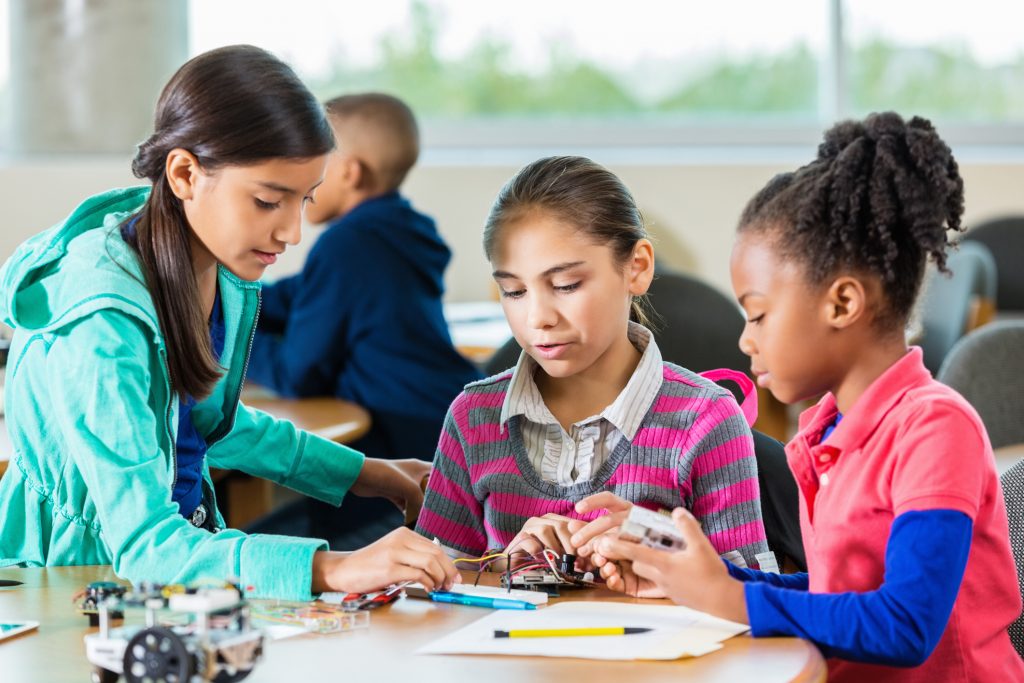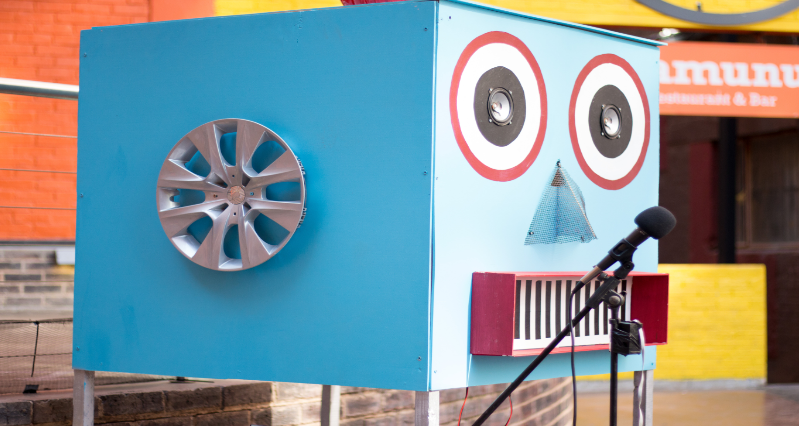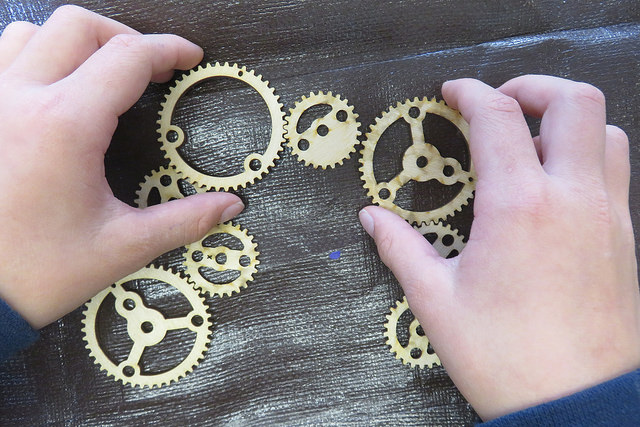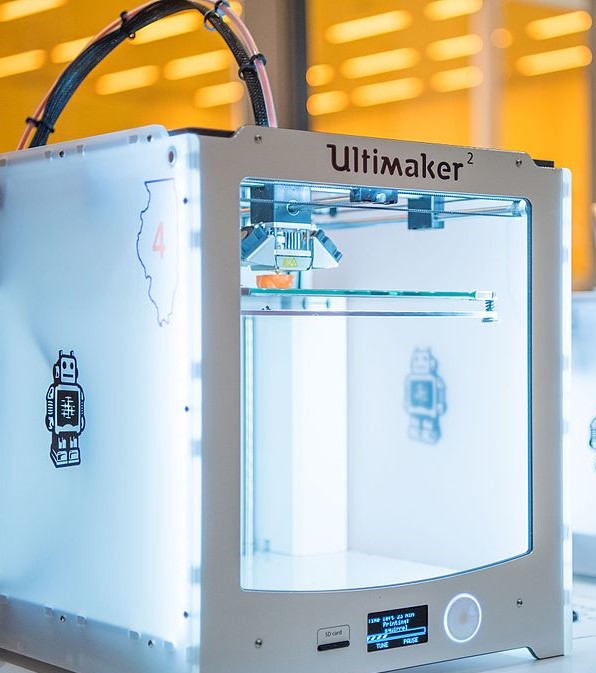
As part of the Teaching, Learning, and Assessment 1 class in the
SPU Digital Education Leadership program, I wanted to investigate best practices for designing meaningful elementary makerspace projects that balance student engagement, empowerment, and self-efficacy while avoiding the frustration that can be caused by open-ended projects and challenging technology.
Background
Making in Education
In his research on makerspaces and education, Lee Martin (2015) defines making as “…designing, building, modifying, and/or repurposing material objects for playful or useful ends,” and identifies the maker mindset as asset- and growth-oriented, “failure-positive” and collaborative (pp. 31; 35). Makers choose what they want to work on and believe that through research, trial and error, and help from the community, they can learn (and share) the skills required to accomplish their goals. Maker activities are well suited to building many of the 21st Century “Career and Life Skills” described by Kivunja (2015), including flexibility and adaptability; initiative and self direction; social skills; and productivity, accountability and responsibility.
Making vs. Project Based Learning and Design Based Learning
Maker activities in schools complement Project Based Learning (PBL) and Design Based Learning (DBL) instructional strategies as both are inquiry-based and loosely structured to allow students to pursue individual areas of interest, often within a defined content area. In both strategies, students learn background information on a subject, identify problems that need to be solved, research and brainstorm potential solutions and select one based on further research, reflection and/or testing. In the case of DBL, proposed solutions are prototyped, tested and modified based on testing (DBL: Vongkulluksn et. al., 2018; PBL: Wolpert-Gawan, 2015). In this sense, Making probably most closely parallels DBL.
Inquiry
Self Efficacy and Motivation in an Elementary Makerspace Environment
Research conducted by Vongkulluksun, Matewos, Sinatra, and Marsh (2018) studied one hundred 3rd – 6th grade students from a private school in California to understand how self-efficacy and situational interest changed over the course of a semester-long DBL makerspace project. Students were asked to define a question based on a real-world need and design a potential solution. As an example, one 6th grader chose to create a “grow with you” prosthetic limb for children that would require him to learn how to use 3D modeling software and a 3D printer. Students were divided into two sections: 3rd and 4th grade and 5th and 6th grade groups, and were given the choice of working in pairs or on their own. Researchers measured students’ self-efficacy levels at the beginning, midway, and at the end of the semester, and also measured situational interest and achievement emotions, including frustration, confusion, excitement and curiosity, midway and at the end of the semester.
The study, which included both quantitative and qualitative methodology indicated:
- Self-efficacy (belief that one can successfully complete the project) and situational interest were “high in general across time points, remaining higher than the median score i.e., 3 out of the possible 5, for most of the students” (pp. 7-8).
- Students’ self-efficacy decreased midway through when the reality of their task set in. The decrease was greater among the upper-level class which the researchers attributed to the greater complexity of their projects. Self-efficacy levels did not change significantly, however, between the midpoint and the end of the semester.
- Situational interest decreased significantly from the midpoint of the semester to the end and the study’s quantitative data showed that self-efficacy beliefs were associated with situational interest.
- Achievement Emotions of excitement and frustration were significantly associated with situational interest, and as one would suspect, “…frustration was found to be significantly and negatively associated with situational interest” (p. 12).
Key Takeaways for my inquiry

1 Makespace projects can be exciting and motivating for elementary-aged students.
As the researchers note, “Students’ personal ownership of their design project is optimal for triggering situational interest, as collaborated by quantitative descriptive results showing moderately high levels of interest present at the beginning of the semester” (Vongkulluksun, et al., p. 13).

2 Ongoing belief in their ability to complete their project (self-efficacy) is key to keeping students motivated and interested.
The researchers suggest it is key for students to “…come to a personal understanding of what solving their specific problem requires” (Vongkulluksun et al., 2018, p. 14), and therefore it is particularly important for teachers to provide scaffolding and support in the beginning when students are attempting to define the scope and the sequence of their project. They also stressed the need for ongoing support for self-efficacy through “…verbal persuasion to convince students of their ability, and small successive goals to maintain self-efficacy levels” (p. 16). The age of the students also called for more scaffolding than might be found in DBL projects in middle or high school since, as the researchers noted, elementary students might not have the emotional regulation skills needed to deal with negative feelings such as frustration or confusion (p. 16).

3 Digital tools found in makerspaces and the STEM skills required to use them can cause frustration which is negatively associated with situational interest.
Though the researchers don’t specifically call out digital tools as the primary source of student difficulty, they do mention that “rudimentary” understanding of STEM concepts due to the students’ grade levels contributed to negative emotions and a decline in self-efficacy (Vongkulluksun et al., 2018, p. 16). I know from experience how challenging it can be for elementary students when learning how to work with 3D printers, electronics, microcontrollers, coding, and many other tools typically found in a makerspace. It takes practice and access to knowledgeable adults for the majority of students to feel adept at using these tools.
Implications for Elementary Makerspaces Beyond the Private School Setting
The study described above was conducted at a private school in a relatively affluent area with a typically “high performing” student population who had access to sophisticated digital tools and instruction from kindergarten through their current grades (Vongkulluksun, et al., 2018). The students also had ready access throughout the semester to mentors familiar with these tools.
Self-efficacy and situational interest could be very different at a school with fewer resources, less flexibility, or a struggling student population. In order to offset this, it seems that focusing on what makes PBL and DBL projects successful, such as proper initial scaffolding, interim milestones and ongoing teacher support, is key.
The makerspace material and tool challenges should be considered part of the scaffolding and addressed when teachers are helping students define the scope and sequence of the problem they want to solve.
If necessary, teachers should consult with those in their school who are familiar with makerspace tools to determine what level of STEM skills are required and how available these experts would be to help their students. Also, prior to the main project, it might be useful to assign students a set of smaller, skill-focused projects such as designing and printing a 3D object or writing a program in Scratch. This would not only help students become proficient with makerspace tools but also give them a realistic sense of the the time and skill level required to use them (Worsley & Blikstein, 2013).
Conclusion
Maker activities in elementary offer the opportunity for deep personal and collaborative learning and strongly support the ISTE student standard 1: Empowered Learner. Given the proper parameters and guidance, students learn how to define a vision (1a) and make it real through planning, iteration, and sharing ideas and artifacts with other students (1b, 1c). They assess what they’ve made based on peer feedback and by comparing their work to their initial vision. And they learn to use and apply multiple digital technologies to help them solve the problem they defined (1c, 1d), (ISTE Standards for Students, 2016).
If teachers can make an accurate assessment of the time they have to devote to a project that incorporates maker activities, the STEM skill levels of their students, and the availability of mentors who can assist with Maker-specific tools or activities, they can help students choose projects that are within their abilities so their interest and self-efficacy levels remain elevated throughout the project. As Martin (2015) suggests, schools need to “…construct their own version of the maker mindset appropriate to the local context,” and that it is dangerous to assume that the power of the Maker Movement “…lies primarily in its revolutionary tool set” (pp. 36-37).
The document below contains a table I created to help organize my thoughts regarding this inquiry, and look forward to adding to it or modifying it with feedback from my learning community.
 Loading…
Loading…
References
ISTE Standards for Students (2016). Retrieved from: https://www.iste.org/standards/for-students
Kivunja, C. (2015). Teaching students to learn and to work well with 21st century skills: Unpacking the career and life skills domain of the new learning paradigm. International Journal of Higher Education, 4:(1), p.1-11. Retrieved from: https://files.eric.ed.gov/fulltext/EJ1060566.pdf
Martin, L. (2015). The promise of the maker movement for education. Journal of Pre-College Engineering Education Research (J-PEER) 5(1), Article 4. Retrieved from: https://docs.lib.purdue.edu/cgi/viewcontent.cgi?article=1099&context=jpeer
Vongkulluksn, V.W., Matewos, A.M., Sinatra, G.M., & Marsh, J.A. (2018). Motivational factors in makerspaces: a mixed methods study of elementary school students’ situational interest, self-efficacy, and achievement emotions. International Journal of STEM Education, 5(43) Retrieved from: https://stemeducationjournal.springeropen.com/articles/10.1186/s40594-018-0129-0
Wolpert-Gawan, H. (2015.) What the heck is Project-Based Learning. Edutopia. Retrieved from: https://www.edutopia.org/blog/what-heck-project-based-learning-heather-wolpert-gawron
Worsley, M. & Blikstein, P. (2013). Designing for diversely motivated learners. Paper Presented at the Digital Fabrication and Making In Education Workshop at the 2013 Interactive Design for Children Conference (IDC 2013). New York, NY. Retrieved from: https://www.marceloworsley.com/papers/dfm_idc_2013.pdf
Photo Credits
Blue Robot Box: Palesa via Unsplash/Piktochart. Retreived from: https://unsplash.com/@palesa08?utm_source=Piktochart&utm_medium=referral
3d Printer at HackIllinois 2016: Rauhul Varma, 2016. Attribution: CC BY-SA 4.0. Retrieved from: https://commons.wikimedia.org/wiki/File:3d_Printer_at_HackIllinois_2016.jpg
Hand and Gears: Fabrice Floren, 2017 via Flickr.com AttributionCC BY-SA 2.0. Retrieved from: https://bit.ly/2R4MkT7
Bridget- After reading your post I felt so inspired to learn more about Makespace projects! I liked the way you were able to explain how Makerspace projects differ from PBL and DBL. I also thought your post was visually appealing and made it clear what your major takeaways were from your research. Thank you for teaching me something new!
Bridget,
I am so impressed with this post. I love how comprehensive it is. The document you created is clear and very helpful. It answered so many questions with research and perspectives. I really enjoyed reading this as I am so interested in the makerspace movement. I think that many people would benifit from the work you did here compiling resources and from the conclusions you drew. I hope you don’t mind me sharing it with my school librarian and a district technology specialist. They are both working on makerspaces and still in the reseach phase. They would definitly benifit from this research. Thank you for sharing.